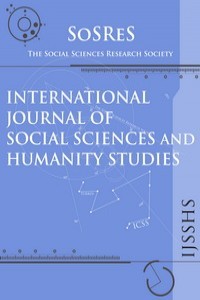THE NEW DIMENSIONS OF THE URBAN ORGANIZATION FROM THE LOCAL TO THE UNIVERSAL: A COMMUNICATIONBASED APPROACH
THE NEW DIMENSIONS OF THE URBAN ORGANIZATION FROM THE LOCAL TO THE UNIVERSAL: A COMMUNICATIONBASED APPROACH
Urban, Urban Organization Urban Communication,
___
- Cereci, S. (2010), Kent Planlaması Bağlamında Kentsel Alanlarda İletişim Ortamlarının Oluşturulması Sorunu, Akademik Bakış Dergisi, 22, pp: 1-9, http://www.akademikbakis.org/eskisite/22/05.pdf (Accessed: 01. 04. 2018)
- Geray, C. (1997), Yerelleşme Üzerine, Ada- Kentliyim Dergisi, 9, MartMayıs, pp. 84-85.
- Güngör, N. ( 2011), İletişim, Kuramlar ve Yaklaşımlar, Siyasal Kitapevi, pp. 36-37, Ankara.
- Kıray, M. (1972), Örgütleşemeyen Kent, İzmir’de İş Hayatının Yapısı ve Yerleşme Düzeni, Sosyal Bilimler Derneği Yayınları, A-1, p.1, Ankara.
- Mutlu, E. (1995), İletişim Sözlüğü, Ark Yayınevi, p. 168, Ankara.
- Örs F. , Örs M.Ş. (2008), Yerelge, Toplumsal Belediyecilik, pp: 37-38, Etki Yayınları, İzmir.
- Tatlıdil, E. (2009), Kent ve Kentli Kimliği; İzmir Örneği, Ege Akademik Bakış, 9 (1), pp. 319-336.
- Tosun, E. (2017), Sürdürülebilirlik Bağlamında Ekolojik Kent Söylemi, AİBÜ Sosyal Bilimler Enstitüsü Dergisi, 2017, Cilt:17, Yıl:17, Sayı: 4, pp. 169-189.
- http://sbedergi.ibu.edu.tr/index.php/sbedergi/article/viewFile/1439/1471, (Accessed: 20. 04. 2018)
- Tüfekçioğlu, H. (1997), İletişim Sosyolojisine Giriş, Der Yayınları, pp. 83- 84 İstanbul.
- Zıllıoğlu, M. (2003), İletişim Nedir? Cem Yayınevi, pp. 13-15, İstanbul.
- Başlangıç: 2009
- Yayıncı: Sosyal Bilimler Araştırmaları Derneği
IS GENDER AND EDUCATION OF TOURISTS’ DETERMINANT FOR VALUE PERCEPTIONS?
Bekir Bora DEDEOĞLU, Fulden Nuray KÜÇÜKERGİN, Kemal Gürkan KÜÇÜKERGİN
THE USE OF HISTORICAL BUILDINGS FOR TOURISTIC PURPOSES: THE CASE OF KARATAY MADRASAH
Elif Merve YILMAZ, Mine ULUSOY
LEVEL OF ATTRACTIVENESS OF BEACH TOURISM OBJECT IN SIJUK DISTRICT, BELITUNG REGENCY, INDONESIA
Wahyu Widi ASTUTİ, Dewi SUSİLONİNGTYAS S.Sİ, M.Sİ, Yuliyanti MAULİDA
MODELLING INTENTION TO VISIT WORLD MONUMENT FUNDED SITE
Tuan Mastiniwati Tuan MANSOR, Abdul Hafaz NGAH
Kurniasih ANDERESTA, Octavira MARETTA, Rara Min ARSYİLLAH
A QUALITY ASSESSMENT STUDY ON THE EAST COAST ROAD OF TAMIL NADU, INDIA
Velmurugan PASUPATHİ, Dr. B. GEORGE
MOBILITIES: ITS SCOPE AND REFLECTIONS ON TURKISH TOURISM STUDIES
